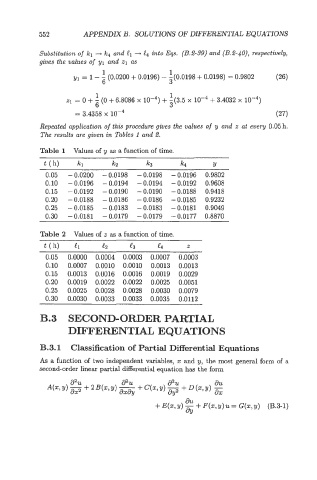Page 572 - Modelling in Transport Phenomena A Conceptual Approach
P. 572
552 APPENDIX 33. SOLUTIONS OF DFFEmNT1A.L EQUATIONS
Substitution of kl --t k4 and C1 --t 4 into Eqs. (B.2-39) and (B.S4O), respectively,
gives the values of y1 and z1 as
1 1
91 = 1 - - (0.0200 + 0.0196) - -(0.0198 + 0.0198) = 0.9802 (26)
6 3
1 1
z1 = 0 + - (0 + 6.8086 x + -(3.5 x + 3.4032 x
6 3
= 3.4358 x (27)
Repeated application of this procedure gives the values of y and z at every 0.05 h.
The results are given in Tables 1 and 2.
Thble 1 Values of y as a function of time.
t (h) kl IC2 k3 k4 Y
0.05 - 0.0200 - 0.0198 - 0.0198 - 0.0196 0.9802
0.10 - 0.0196 - 0.0194 - 0.0194 - 0.0192 0.9608
0.15 - 0.0192 - 0.0190 - 0.0190 - 0.0188 0.9418
0.20 - 0.0188 - 0.0186 - 0.0186 - 0.0185 0.9232
0.25 - 0.0185 - 0.0183 - 0.0183 - 0.0181 0.9049
0.30 - 0.0181 - 0.0179 - 0.0179 - 0.0177 0.8870
nble 2 Values of z as a function of time.
0.05 0.0000 0.0004 0.0003 0.0007 0.0003
0.10 0.0007 0.0010 0.0010 0.0013 0.0013
0.15 0.0013 0.0016 0.0016 0.0019 0.0029
0.20 0.0019 0.0022 0.0022 0.0025 0.0051
0.25 0.0025 0.0028 0.0028 0.0030 0.0079
0.30 0.0030 0.0033 0.0033 0.0035 0.0112
B.3 SECOND-ORDER PARTIAL
DIFFEFtENTIAL EQUATIONS
B.3.1 Classification of Partial Differential Equations
As a function of two independent variables, x and y, the most general form of a
second-order linear partial differential equation has the form
azl
+ E(z, 9) - + F(x,Y) u = G(z, 9) (B.3-1)
aY

